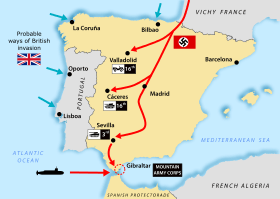Spain during World War II
During World War II the Spanish State under Francisco Franco espoused neutrality as its official wartime policy. This neutrality wavered at times and "strict neutrality" gave way to "non-belligerence" after the Fall of France in June 1940. Franco wrote to Adolf Hitler offering to join the war on 19 June 1940.[1] Later the same year Franco met with Hitler in Hendaye to discuss Spain's possible accession to the Axis Powers. The meeting went nowhere, but Spain would help the Axis — whose members Italy and Germany had supported him during the Spanish Civil War — in various ways.
| Part of a series on |
| Francoism |
|---|
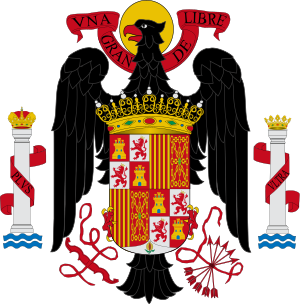 |
|
Despite ideological sympathy, Franco even stationed field armies in the Pyrenees to deter Axis occupation of the Iberian Peninsula. The Spanish policy frustrated Axis proposals that would have encouraged Franco to take British-controlled Gibraltar.[2] Much of the reason for Spanish reluctance to join the war was due to Spain's reliance on imports from the United States. Spain was still recovering from its civil war and Franco knew his armed forces would not be able to defend the Canary Islands and Spanish Morocco from a British attack.[3]
In 1941 Franco approved the recruitment of volunteers to Germany on the guarantee that they only fight against the Soviet Union and not against the western Allies. This resulted in the formation of the Blue Division which fought as part of the German army on the Eastern Front between 1941 and 1944.
Spanish policy would return to "strict neutrality" as the tide of war started to turn against the Axis. American pressure in 1944 for Spain to stop tungsten exports to Germany and to withdraw the Blue Division led to an oil embargo which forced Franco to yield. After the war Spain was not allowed to join the newly created United Nations because of the wartime support for the Axis and it would be isolated by many other countries until the mid-1950s.
Domestic politics
During World War II, Spain was governed by an autocratic government,[4] but despite Franco's own pro-Axis leanings and debt of gratitude to Benito Mussolini and Adolf Hitler, the government was divided between Germanophiles and Anglophiles. When the war started, Juan Beigbeder Atienza, an Anglophile, was the minister of foreign affairs. The rapid German advance in Europe convinced Franco to replace him with Ramón Serrano Súñer, Franco's brother-in-law and a strong Germanophile (18 October 1940). After the Allied victories in North Africa, Franco changed tack again, appointing Francisco Gómez-Jordana Sousa, sympathetic to the British, as minister in September 1942. Another influential Anglophile was the Duke of Alba, Spain's ambassador in London.
Diplomacy
From the very beginning of World War II, Spain favoured the Axis Powers. Apart from ideology, Spain had a debt to Germany of $212 million for supplies of matériel during the Civil War. Indeed, in June 1940, after the Fall of France, the Spanish Ambassador to Berlin had presented a memorandum in which Franco declared he was "ready under certain conditions to enter the war on the side of Germany and Italy". Franco had cautiously decided to enter the war on the Axis side in June 1940, and to prepare his people for war, an anti-British and anti-French campaign was launched in the Spanish media that demanded French Morocco, Cameroon and the return of Gibraltar.[5] On 19 June 1940, Franco pressed along a message to Hitler saying he wanted to enter the war, but Hitler was annoyed at Franco's demand for the French colony of Cameroon, which had been German before World War I, and which Hitler was planning on taking back.[6]
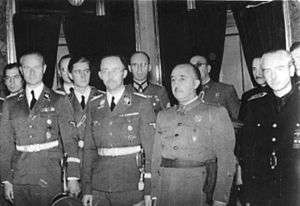
At first Adolf Hitler did not encourage Franco's offer, as he was convinced of eventual victory. In August 1940, when Hitler became serious about having Spain enter the war, a major problem that emerged was the German demand for air and naval bases in Spanish Morocco and the Canaries, which Franco was completely opposed to.[7] After the victory over France, Hitler had revived Plan Z (shelved in September 1939) for having a huge fleet with the aim of fighting the United States, and he wanted bases in Morocco and the Canary islands for the planned showdown with America.[8] The American historian Gerhard Weinberg wrote: "The fact that Germans were willing to forgo Spain's participation in the war rather than abandon their plans for naval bases on and off the coast of Northwest Africa surely demonstrates the centrality of this latter issue to Hitler as he looked forward to naval war with the United States".[8] In September, when the Royal Air Force had demonstrated its resilience in defeating the Luftwaffe in the Battle of Britain, Hitler promised Franco help in return for its active intervention. This had become part of a strategy to forestall Allied intervention in north-west Africa. Hitler promised that "Germany would do everything in its power to help Spain" and would recognise Spanish claims to French territory in Morocco, in exchange for a share of Moroccan raw materials. Franco responded warmly, but without any firm commitment. Falangist media agitated for irredentism, claiming for Spain the portions of Catalonia and the Basque Country that were still under French administration.[9][10]
Hitler and Franco met only once at Hendaye, France on 23 October 1940 to fix the details of an alliance. By this time, the advantages had become less clear for either side. Franco asked for too much from Hitler. In exchange for entering the war alongside the alliance of Germany and Italy, Franco, among many things, demanded heavy fortification of the Canary Islands as well as large quantities of grain, fuel, armed vehicles, military aircraft and other armaments. In response to Franco's nearly impossible demands, Hitler threatened Franco with a possible annexation of Spanish territory by Vichy France. At the end of the day, no agreement was reached. A few days later in Germany, Hitler would famously tell Mussolini, "I prefer to have three or four of my own teeth pulled out than to speak to that man again!" It is subject to historical debate whether Franco overplayed his hand by demanding too much from Hitler for Spanish entry into the war, or if he deliberately stymied the German dictator by setting the price for his alliance unrealistically high, knowing that Hitler would refuse his demands and thus save Spain from entering another devastating war.
Spain relied upon oil supplies from the United States, and the US had agreed to listen to British recommendations on this. As a result, the Spanish were told that supplies would be restricted, albeit with a ten-week reserve. Lacking a strong navy, any Spanish intervention would rely, inevitably, upon German ability to supply oil. Some of Germany's own activity relied upon captured French oil reserves, so additional needs from Spain were unhelpful. From the German point of view, Vichy's active reaction to British and Free French attacks (Destruction of the French Fleet at Mers-el-Kebir and Dakar) had been encouraging, so perhaps Spanish intervention was less vital. Also, in order to keep Vichy "on-side", the proposed territorial changes in Morocco became a potential embarrassment and were diluted. As a consequence of this, neither side would make sufficient compromises and after nine hours, the talks failed.
In December 1940, Hitler contacted Franco again via a letter sent by the German ambassador to Spain and returned to the issue of Gibraltar. Hitler attempted to force Franco's hand with a blunt request for the passage of several divisions of German troops through Spain to attack Gibraltar. Franco refused, citing the danger that the United Kingdom still presented to Spain and the Spanish colonies. In his return letter, Franco told Hitler that he wanted to wait until Britain "was on the point of collapse". In a second diplomatic letter, Hitler got tougher and offered grain and military supplies to Spain as an inducement. By this time, however, Italian troops were being routed by the British in Cyrenaica and Italian East Africa, and the Royal Navy had displayed its freedom of action in Italian waters. The UK was clearly not finished. Franco responded "that the fact has left the circumstances of October far behind" and "the Protocol then agreed must now be considered outmoded".
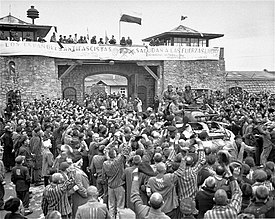
According to Franco's own autobiography, he also met privately once with Italian leader Benito Mussolini in Bordighera, Italy on 12 February 1941[11] at Hitler's request. Hitler hoped that Mussolini could persuade Franco to enter the war. However, Mussolini was not interested in Franco's help after the series of defeats his forces had recently suffered in North Africa and the Balkans.
Franco signed the Anti-Comintern Pact on 25 November 1941. In 1942, the planning of Operation Torch (American landings in North Africa) was considerably influenced by the apprehension that it might precipitate Spain to abandon neutrality and join the Axis, in which case the Straits of Gibraltar might be closed. In order to meet this contingency, it was decided by the Combined Chiefs of Staff to include a landing in Casablanca, in order to have an option of an overland route via Moroccan territory bypassing the Straits.
Franco's policy of open support to the Axis Powers led to a period of postwar isolation for Spain as trade with most countries ceased. U.S. President Franklin Roosevelt, who had assured Franco that Spain would not suffer consequences from the Allies, died in April 1945. Roosevelt's successor, Harry S. Truman, as well as new Allied governments, were less friendly to Franco. A number of nations withdrew their ambassadors, and Spain was not admitted to the United Nations until 1955.
Military
Although it sought to avoid entering the war, Spain did make plans for defense of the country. Initially, the mass of the Spanish army was stationed in southern Spain in case of an Allied attack from Gibraltar during 1940 and 1941. However, Franco ordered the divisions to gradually redeploy in the mountains along the French border in case of a possible German invasion of Spain as Axis interest in Gibraltar grew. By the time it became clear that the Allies were gaining the upper hand in the conflict, Franco had amassed all his troops on the French border and received personal assurances from the leaders of Allied countries that they did not wish to invade Spain.
Operation Felix
Before Franco and Hitler's October 1940 meeting in Hendaye, there had been Spanish-German planning for an attack, from Spain, upon the British territory of Gibraltar which was, and is, a British dependency and military base. At the time, Gibraltar was important for control of the western exit from the Mediterranean and the sea routes to the Suez Canal and Middle East, as well as Atlantic patrols.
The Germans also appreciated the strategic importance of north-west Africa for bases and as a route for any future American involvement. Therefore, the plans included the occupation of the region by substantial German forces, to forestall any future Allied invasion attempt.
The plan, Operation Felix, was in detailed form before the negotiations failed at Hendaye. By March 1941, military resources were being ear-marked for Barbarossa and the Soviet Union. Operation Felix-Heinrich was an amended form of Felix that would be invoked once certain objectives in Russia had been achieved. In the event, these conditions were not fulfilled and Franco still held back from entering the war.[14]
After the war, Field Marshal Wilhelm Keitel said: "Instead of attacking Russia, we should have strangled the British Empire by closing the Mediterranean. The first step in the operation would have been the conquest of Gibraltar. That was another great opportunity we missed."[15] If that had succeeded, Hermann Göring proposed that Germany would "... offer Britain the right to resume peaceful traffic through the Mediterranean if she came to terms with Germany and joined us in a war against Russia".[14]
As the war progressed and the tide turned against the Axis, the Germans planned for the event of an Allied attack through Spain. There were three successive plans, progressively less aggressive as German capability waned:
Operation Isabella
This was planned in April 1941 as a reaction to a proposed British landing on the Iberian peninsula near Gibraltar. German troops would advance into Spain to support Franco and expel the British wherever they landed.
Operation Ilona or Gisella
Ilona was a scaled down version of Isabella, subsequently renamed Gisella. Devised in May 1942, to be invoked whether or not Spain stayed neutral. Ten German divisions would advance to Barcelona and, if necessary, towards Salamanca to support the Spanish army in fighting another proposed Allied landing either from the Mediterranean or Atlantic coasts.
Operation Nurnberg
Devised in June 1943, Nurnberg was purely a defensive operation in the Pyrenees along both sides of the Spanish-French border in the event of Allied landings in the Iberian peninsula, which were to repel an Allied advance from Spain into France.
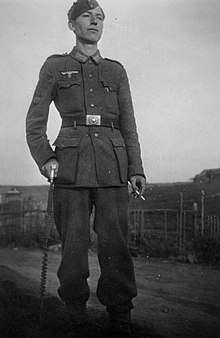
Occupation of Tangier
Spanish troops occupied the Tangier International Zone on 14 June 1940, the same day Paris fell to the Germans. Despite calls by the writer Rafael Sánchez Mazas and other Spanish nationalists to annex Tangier, the Franco regime publicly considered the occupation a temporary wartime measure.[16] A diplomatic dispute between Britain and Spain over the latter's abolition of the city's international institutions in November 1940 led to a further guarantee of British rights and a Spanish promise not to fortify the area.[17] In May 1944, although it had served as a contact point between him and the later Axis Powers during the Spanish Civil War, Franco expelled all German diplomats from the area.[18]
The territory was restored to its pre-war status on 11 October 1945.[19] In July 1952 the protecting powers met at Rabat to discuss the Zone's future, agreeing to abolish it. Tangier joined with the rest of Morocco following the restoration of full sovereignty in 1956.[20]
Volunteers
The main part of Spain's involvement in the war was through volunteers. They fought for both sides, largely reflecting the allegiances of the civil war.
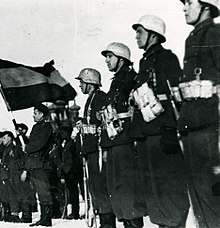
Spanish volunteers in Axis service
Although Spanish caudillo Francisco Franco did not bring Spain into World War II on the side of the Axis, he permitted volunteers to join the German Army on the clear and guaranteed condition they would fight against Bolshevism (Soviet Communism) on the Eastern Front, and not against the western Allies. In this manner, he could keep Spain at peace with the western Allies, while repaying German support during the Spanish Civil War and providing an outlet for the strong anti-Communist sentiments of many Spanish nationalists. Spanish foreign minister Ramón Serrano Súñer suggested raising a volunteer corps, and at the commencement of Operation Barbarossa, Franco sent an official offer of help to Berlin.
Hitler approved the use of Spanish volunteers on 24 June 1941. Volunteers flocked to recruiting offices in all the metropolitan areas of Spain. Cadets from the officer training school in Zaragoza volunteered in particularly large numbers. Initially, the Spanish government was prepared to send about 4,000 men, but soon realized that there were more than enough volunteers to fill an entire division: – the Blue Division or División Azul under Agustín Muñoz Grandes – including an air force squadron – the Blue Squadron, 18,104 men in all, with 2,612 officers and 15,492 soldiers.
The Blue Division was trained in Germany before serving in the Siege of Leningrad, and notably at the Battle of Krasny Bor, where General Infantes' 6,000 Spanish soldiers threw back some 30,000 Soviet troops. In August 1942, it was transferred north to the southeastern flank of the Siege of Leningrad, just south of the Neva near Pushkin, Kolpino and Krasny Bor in the Izhora River area. After the collapse of the German southern front following the Battle of Stalingrad, more German troops were deployed southwards. By this time, General Emilio Esteban Infantes had taken command. The Blue Division faced a major Soviet attempt to break the siege of Leningrad in February 1943, when the 55th Army of the Soviet forces, reinvigorated after the victory at Stalingrad, attacked the Spanish positions at the Battle of Krasny Bor, near the main Moscow-Leningrad road. Despite very heavy casualties, the Spaniards were able to hold their ground against a Soviet force seven times larger and supported by tanks. The assault was contained and the siege of Leningrad was maintained for a further year. The division remained on the Leningrad front where it continued to suffer heavy casualties due to weather and to enemy action[7], In October 1943, under severe diplomatic pressure, the Blue Division was ordered home leaving a token force until March 1944. In all, about 45,000 Spanish served on the Eastern Front, mostly committed volunteers, and around 4,500 died. Joseph Stalin's desire to retaliate against Franco by making an Allied invasion of Spain the first order of business at the Potsdam Conference in July 1945, was not supported by Harry S. Truman and Winston Churchill. War weary and unwilling to continue the conflict, Truman and Churchill persuaded Stalin to instead settle for a full trade embargo against Spain.
372 members of the Blue Division, the Blue Legion, or volunteers of the Spanische-Freiwilligen Kompanie der SS 101 were taken prisoner by the victorious Red Army; 286 of these men were kept in captivity until 2 April 1954, when they returned to Spain aboard the ship Semiramis, supplied by the International Red Cross.[21][22].
Spanish volunteers in Allied service
After their defeat in the Spanish Civil War, numbers of Republican veterans and civilians went into exile in France; the French Republic interned them in refugee camps, such as Camp Gurs in southern France. To improve their conditions, many joined the French Foreign Legion at the start of World War II, making up a sizeable proportion of it. Around sixty thousand joined the French Resistance, mostly as guerrillas, with some also continuing the fight against Francisco Franco.[23] Several thousand more joined the Free French Forces and fought against the Axis Powers. Some sources have claimed that as many as 2,000 served in General Leclerc's Second French Division, many of them from the former Durruti Column.[note 1]
The 9th Armoured Company comprised almost entirely battle-hardened Spanish veterans; it became the first Allied military unit to enter Paris upon its liberation in August, 1944, where it met up with a large number of Spanish Maquis fighting alongside French resistance fighters. Furthermore, 1,000 Spanish Republicans served in the 13th Half-brigade of the French Foreign Legion.[24]
In Eastern Europe, the Soviet Union received former Communist Spanish leaders and child evacuees from Republican families. When Germany invaded the Soviet Union in 1941, many, such as communist General Enrique Líster, joined the Red Army. According to Beevor, 700 Spanish Republicans served in the Red Army and another 700 operated as partisans behind the German lines.[24] Individual Spaniards, such as the double-agent Juan Pujol García (code name GARBO), also worked for the Allied cause.
Bribes by MI6
According to a 2008 book, Winston Churchill authorised millions of dollars in bribes to Spanish generals in an effort to influence General Franco against entering the war on the side of Germany.[25] In May 2013 files were released showing MI6 spent the present-day equivalent of more than $200 million bribing senior Spanish military officers, ship owners and other agents to keep Spain out of the war.[26]
Resources and trade
Despite lacking cash, oil and other supplies, Francoist Spain was able to supply some essential materials to Germany. There was a series of secret war-time trade agreements between the two countries. The principal resource was wolfram (or tungsten) ore from German-owned mines in Spain. Tungsten was essential to Germany for its advanced precision engineering and therefore for armament production. Despite Allied attempts to buy all available supplies, which rocketed in price, and diplomatic efforts to influence Spain, supplies to Germany continued until August 1944.
Payment for wolfram was effectively set against the Spanish debt to Germany. Other minerals included iron ore, zinc, lead and mercury. Spain also acted as a conduit for goods from South America, for example, industrial diamonds and platinum. After the war, evidence was found of significant gold transactions between Germany and Spain, ceasing only in May 1945. It was believed that these were derived from Nazi looting of occupied lands, but attempts by the Allies to obtain control of the gold and return it were largely frustrated.
Espionage and sabotage
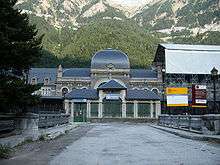
As long as Spain permitted it, the Abwehr – the German intelligence organisation – was able to operate in Spain and Spanish Morocco, often with cooperation of the Nationalist government. Gibraltar's installations were a prime target for sabotage, using sympathetic anti-British Spanish workers. One such attack occurred in June 1943, when a bomb caused a fire and explosions in the dockyard. The British were generally more successful after this and managed to use turned agents and sympathetic anti-Fascist Spaniards to uncover subsequent attacks. A total of 43 sabotage attempts were prevented in this way. By January 1944, a Gibraltarian and two Spanish workers, convicted of attempted sabotage, had been executed.[27]
The Abwehr also financed, trained and equipped saboteurs to attack British naval assets. The Germans contacted a Spanish staff officer from Campo de Gibraltar, Lieutenant Colonel Eleuterio Sánchez Rubio, a Spanish army officer, member of the Falange and coordinator of the intelligence operations in the Campo,[28] to establish a network of saboteurs with access to Gibraltar. Sánchez Rubio designated Emilio Plazas Tejera, also a member of Falange, as operations chief of the organisation.[29] The Spanish agents sank the armed trawler HMT Erin, and destroyed the auxiliary minesweeper HMT Honju, which resulted in the deaths of six British seamen on 18 January 1942.[30][31][32] Plazas was assisted by the Spanish naval commander of Puente Mayorga, Manuel Romero Hume, who allowed him to beach a rowboat there.[27]
The Abwehr also maintained observation posts along both sides of the Straits of Gibraltar, reporting on shipping movements. A German agent in Cádiz was the target of a successful Allied disinformation operation, Operation Mincemeat, prior to the invasion of Sicily in 1943. In early 1944, the situation changed. The Allies were clearly gaining the advantage over the Axis and one double agent had provided enough information for Britain to make a detailed protest to the Spanish government. As a result, the Spanish government declared its "strict neutrality". The Abwehr operation in southern Spain was consequently closed down. The rail station of Canfranc was the conduit for the smuggling of people and information from Vichy France to the British consulate in San Sebastián. The nearer border station of Irún could not be used as it bordered occupied France.
Jews and other refugees
In the first years of the war, "Laws regulating their admittance were written and mostly ignored."[33] They were mainly from Western Europe, fleeing deportation to concentration camps from occupied France, but also Jews from Eastern Europe, especially Hungary. Trudi Alexy refers to the "absurdity" and "paradox of refugees fleeing the Nazis' Final Solution to seek asylum in a country where no Jews had been allowed to live openly as Jews for over four centuries."[34]
Throughout World War II, Spanish diplomats of the Franco government extended their protection to Eastern European Jews, especially in Hungary. Jews claiming Spanish ancestry were provided with Spanish documentation without being required to prove their case and either left for Spain or survived the war with the help of their new legal status in occupied countries.
Once the tide of war began to turn, and Count Francisco Gómez-Jordana Sousa succeeded Franco's brother-in-law Serrano Súñer as Spain's foreign minister, Spanish diplomacy became "more sympathetic to Jews", although Franco himself "never said anything" about this.[33] Around that same time, a contingent of Spanish doctors travelling in Poland were fully informed of the Nazi extermination plans by Governor-General Hans Frank, who was under the misimpression that they would share his views about the matter; when they came home, they passed the story to Admiral Luís Carrero Blanco, who told Franco.[35]
Diplomats discussed the possibility of Spain as a route to a containment camp for Jewish refugees near Casablanca, but it came to naught without Free French and British support.[36] Nonetheless, control of the Spanish border with France relaxed somewhat at this time,[37] and thousands of Jews managed to cross into Spain (many by smugglers' routes). Almost all of them survived the war.[38] The American Jewish Joint Distribution Committee operated openly in Barcelona.[39]
Shortly afterwards, Spain began giving citizenship to Sephardic Jews in Greece, Hungary, Bulgaria, and Romania; many Ashkenazic Jews also managed to be included, as did some non-Jews. The Spanish head of mission in Budapest, Ángel Sanz Briz, saved thousands of Ashkenazim in Hungary by granting them Spanish citizenship, placing them in safe houses and teaching them minimal Spanish so they could pretend to be Sephardim, at least to someone who did not know Spanish. The Spanish diplomatic corps was performing a balancing act: Alexy conjectures that the number of Jews they took in was limited by how much German hostility they were willing to engender.[40]
Toward the war's end, Sanz Briz had to flee Budapest, leaving these Jews open to arrest and deportation. An Italian diplomat, Giorgio Perlasca, who was himself living under Spanish protection, used forged documents to persuade the Hungarian authorities that he was the new Spanish Ambassador. As such, he continued Spanish protection of Hungarian Jews until the Red Army arrived.[41]
Although Spain effectively undertook more to help Jews escape deportation to the concentration camps than most neutral countries did,[41][42] there has been debate about Spain's wartime attitude towards refugees. Franco's regime, despite its aversion to Zionism and "Judeo"-Freemasonry, does not appear to have shared the rabid anti-Semitic ideology promoted by the Nazis. About 25,000 to 35,000 refugees, mainly Jews, were allowed to transit through Spain to Portugal and beyond.
Some historians argue that these facts demonstrate a humane attitude by Franco's regime, while others point out that the regime only permitted Jewish transit through Spain. After the war, Franco's regime was quite hospitable to those who had been responsible for the deportation of the Jews, notably Louis Darquier de Pellepoix, Commissioner for Jewish Affairs (May 1942 – February 1944) under the Vichy Régime in France, and to many other former Nazis, such as Otto Skorzeny and Léon Degrelle, and other former Fascists.[43]
José María Finat y Escrivá de Romaní, Franco's chief of security, issued an official order dated 13 May 1941 to all provincial governors requesting a list of all Jews, both local and foreign, present in their districts. After the list of six thousand names was compiled, Romaní was appointed Spain's ambassador to Germany, enabling him to deliver it personally to Himmler. Following the defeat of Germany in 1945, the Spanish government attempted to destroy all evidence of cooperation with the Nazis, but this official order survived.[44]
Japanese war reparations
At the end of the war, Japan was compelled to pay high amounts of money or goods to several nations to cover damage or injury inflicted during the war. In the case of Spain, the reparations were due to the deaths of over a hundred Spanish citizens, including several Catholic missionaries, and great destruction of Spanish properties in the Philippines during the Japanese occupation. To that effect, in 1954 Japan concluded 54 bilateral agreements including one with Spain for $5.5 million, paid in 1957.
See also
- Moscow Gold
- Spanish Maquis
- Laurel Incident
- Iberian Pact
- Neutral powers during World War II
Notes
- The number of Spaniards that served in the Second French Armoured Division in World War II remains disputed. The official French Annuaire des anciens combattants de la 2e DB, Imprimerie de Arrault, 1949 claimed there were less than 300 Spaniards.
- Weinberg, Gerhard A World In Arms, Cambridge: Cambridge University Press, 2005 page 177.
- The History Channel. "November 19, 1940: Hitler urges Spain to grab Gibraltar." http://www.history.com/this-day-in-history/hitler-urges-spain-to-grab-gibraltar
- Sager, Murray (July 2009). "Franco, Hitler & the play for Gibraltar: how the Spanish held firm on the Rock". Esprit de Corps. Archived from the original on 2012-07-08.
- Weinberg, Gerhard A World In Arms, Cambridge: Cambridge University Press, 2005 page 133.
- Weinberg, Gerhard A World In Arms, Cambridge: Cambridge University Press, 2005 page 177.
- Weinberg, Gerhard A World In Arms, Cambridge: Cambridge University Press, 2005 pages 176-177.
- Weinberg, Gerhard A World In Arms, Cambridge: Cambridge University Press, 2005 page 178.
- Serrano Suñer, tragedia personal y fascismo político, Javier Tusell, El País, 2 September 2003: "Serrano ante él [Hitler] llegó a sugerir que el Rosellón debia ser español, por catalán, y que Portugal no tenía sentido como unidad política independiente."
- El último de los de Franco, Santiago Pérez Díaz, El País 7 September 2003
- (in Italian) Quotation of Mussolini, Album di una vita by Mario Cervi at the Bordighera site. Accessed online 18 October 2006.
- areamilitar.net. "As forças preparadas para a invasão (Portuguese)".
- Bill Stone. "Second World War Books: Operation Felix: Assault on Gibraltar". stone&stone.
- Shulman, pp. 66–67
- Shulman, p. 68
- Payne 1987, p. 268.
- Payne 1987, p. 274, note 28.
- Beevor 2006, pp. 152, 464.
- "Reestablishment of the International Regime in Tangiers". Department of State Bulletin. Department of State. XIII (330): 613–618. 21 October 1945.
- "Final Declaration of the International Conference in Tangier and annexed Protocol. Signed at Tangier, on 29 October 1956 [1957] UNTSer 130; 263 UNTS 165". 1956.
- Candil, Anthony J. "Post: Division Azul Histories and Memoirs". WAIS - World Association for International Studies. Retrieved 3 June 2014.
- Luca de Tena, Torcuato (1976). Embajador en el infierno (Ambassador to Hell). Barcelona: Editorial Planeta. p. 252. ISBN 84-320-5164-0.
- Crowdy, Terry (2007). French Resistance Fighter: France's Secret Army. Oxford: Osprey Publishing. ISBN 1-84603-076-5 p. 13
- Beevor, Antony. (2006). The Battle for Spain. The Spanish Civil War, 1936–1939. Penguin Books. London. p. 419
- Keeley, Graham (16 October 2008). "Winston Churchill 'bribed Franco's generals to stay out of the war'". Aftermath News.
- https://www.theguardian.com/uk/2013/may/23/mi6-spain-200m-bribes-ww2
- Stockey, Gareth (2009). Gibraltar: A dagger in the spine of Spain?. Sussex Academic Press. pp. 151–52. ISBN 9781845193010.
- Stockey 2009, p. 149.
- Ros Agudo (2005), pp. 232–234
- Royal Navy casualties, January 1942
- Naval Events, January 1942, Part 2
- HMS Erin ASW Trawler Uboat.net
- Alexy, p. 77.
- Trudi Alexy, The Mezuzah in the Madonna's Foot, Simon and Schuster, 1993. ISBN 0-671-77816-1. p. 74.
- Alexy, p. 164–165.
- Alexy, p. 77–78.
- Alexy, p. 165.
- Alexy, p. 79, passim.
- Alexy, p. 154–155, passim.
- Alexy, p. 165 et. seq.
- "Giorgio Perlasca". The International Raoul Wallenberg foundation. Retrieved 21 July 2006.
- "Franco & the Jews". Hitler: Stopped by Franco. Retrieved 21 July 2006.
- Nicholas Fraser, "Toujours Vichy: a reckoning with disgrace", Harper's, October 2006, p. 86–94. The relevant statement about Spain sheltering him is on page 91.
- Haaretz, 22 June 2010, "WWII Document Reveals: General Franco Handed Nazis List of Spanish Jews," http://www.haaretz.com/print-edition/news/wwii-document-reveals-general-franco-handed-nazis-list-of-spanish-jews-1.297546 , citing a report published 20 June 2010 in the Spanish daily El Pais.
Further reading
- Bowen, Wayne H. (2000). Spaniards and Nazi Germany: Collaboration in the New Order. Columbia, MO: University of Missouri Press. p. 250. ISBN 978-0826213006. OCLC 44502380.
- Bowen, Wayne H. (2005). Spain During World War II. Columbia, MO: University of Missouri Press. p. 279. ISBN 978-0826216588. OCLC 64486498.
- Brenneis, Sara J.; Herrmann, Gina, eds. (2020). Spain, the Second World War, and the Holocaust: History and Representation. University of Toronto Press. ISBN 978-1-4875-0570-7.
- Hayes, Carlton J. H. Wartime mission in Spain, 1942–1945 (1945) ISBN 9781121497245. by the U.S. ambassador
- León-Aguinaga, Pablo. "The Trouble with Propaganda: the Second World War, Franco's Spain, and the Origins of US Post-War Public Diplomacy." International History Review 37.2 (2015): 342-365. online
- Payne, Stanley G (2008). Franco and Hitler. New Haven: Yale University Press. ISBN 978-0-300-12282-4.
- Preston, Paul. "Spain" in The Cambridge History of the Second World War: vol 2 (2015) pp 301–323 DOI: https://doi.org/10.1017/CHO9781139524377.016
- Shulman, Milton (1995) [1947]. Defeat in the West. Chailey, East Sussex. ISBN 1-872947-03-4.
- Thomàs, J. ed. Roosevelt and Franco During the Second World War: From the Spanish Civil War to Pearl Harbor (Springer, 2008).
External links
| Wikisource has original text related to this article: |
- 1939–1945: The Spanish Resistance in France
- Nueve Company (French Second Armoured Division)
- The Blue Division
- Spanish Involvement in World War II
- Operation Felix: Assault on Gibraltar
- Excerpt from Christian Leitz, "Spain and Holocaust"
- Libro Memorial. Españoles deportados a los campos nazis (1940-1945), Benito Bermejo and Sandra Checa, Ministerio de Cultura de España, 2006. Re-published in Portable Document Format.
- Los vascos y la II Guerra Mundial, Mikel Rodríguez, Euskonews & Media 301.
- Jimmy Burns, Papa Spy: Love, Faith & Betrayal in Wartime Spain. London, Bloomsbury, 2009.
- Museo Virtual de Españoles en la Segunda Guerra Mundial
